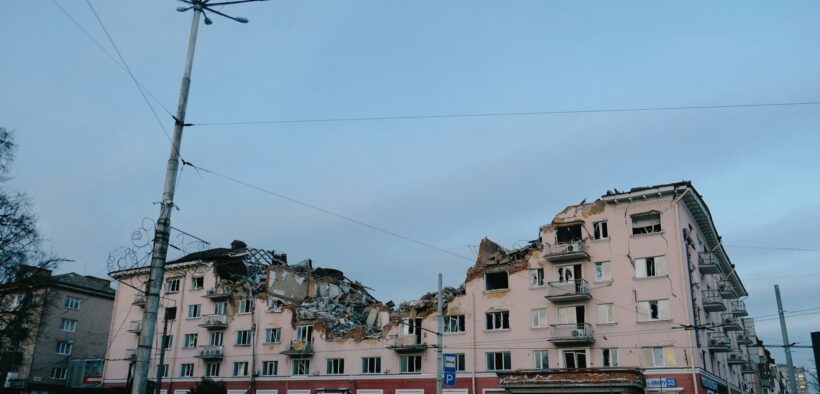The War in Ukraine: The Use of Child-Centered International Law in the ICC’s Prosecution
Share

Image Credits: @fiwol on Unsplash (Unsplash License)
Introduction
Since the beginning of Russia’s invasion of Ukraine on February 24th, 2022, reports of numerous violations of international law have made headlines. Most significantly, International Criminal Court (ICC) Prosecutor Karim Khan opened an investigation into crimes committed in Ukraine. This investigation culminated in the Court’s issuing of two arrest warrants against Vladimir Putin, President of the Russian Federation, and Maria Lvova-Belova, Commissioner for Children’s Rights, for the war crime of unlawful deportation and transfer of population in violation of Articles 8(2)(a)(vii) and 8(2)(b)(viii) of the Rome Statute. Based on reports of the forcible transfer of Ukrainian children to Russia, the crimes Putin and Lvova-Belova are accused of in the arrest warrants centrally affect children. This article will, thus, look into the use of child-centric sources of international law when prosecuting these crimes.
Background on the Crime of Unlawful Deportation and Transfer
It is first required to comprehend the “traditional” understanding of the crime of unlawful deportation and transfer in international law. The crimes of deportation and transfer can be separated into three different levels: unlawful deportation/transfer amounting to a war crime, crime against humanity, and genocide.
Requirements
Of primary concern here is unlawful deportation and transfer amounting to a war crime, as this is the crime charged in the arrest warrants. The ICC identifies several elements which constitute the crimes inscribed in articles 8(2)(a)(vii) and 8(2)(b)(viii). Firstly, the perpetrator must have deported or transferred one or more protected persons to another location in the context of an international armed conflict. This means that the perpetrator is aware that the persons deported were protected under the 1949 Geneva Conventions, the collection of treaties providing the rules applicable in times of war, and that there was an international armed conflict. According to the Geneva Conventions, children are indeed protected persons. Secondly, the perpetrator, to fulfill the criteria of article 8(2)(b)(viii), must have transferred part of its population into the territory it occupies or must have deported part of the population of the occupied territory.
The ICC’s choices
It is crucial to note that the ICC did not elevate the facts in Ukraine to the level of “widespread and systematic attack directed against a civilian population” – the extra element necessary for actions to qualify as a crime against humanity. Aside from these legal qualifications which it is for the Court to make, the issue at hand here could also be understood through the perspective of children’s rights.
The Manner in Which Deportation is Done: International Adoption or War Crime?
There are specific elements about the deportation Russia is allegedly committing in Ukraine that seem to make it different from the description of the war crime in the Rome Statute. Adopting a children’s rights perspective, an approach advocating for incorporating child-rights principles in situations in which children are involved, would highlight just that. The way in which the unlawful deportation and transfer are done is what will first be considered.
Intercountry adoption during wartime
Russia, to justify its deportation, is using the argument that it is “legitimately” displacing Ukrainian children to protect them from the war. Russian families, then, are “legitimately” adopting Ukrainian children to protect them. To give an example of this, Lvova-Belova herself explains that she fostered and adopted a teenager from Mariupol. Specific child-centric provisions of international law are useful in countering these arguments. Firstly, the Geneva Conventions state that children can only be displaced from war zones temporarily and to a third-party state – not the aggressor state itself – with, if possible, the consent of parents or guardians. Additionally, intercountry adoption is not authorized during wartime – making these actions not adoption but forcible deportation. Ukrainian children and their parents were misled into sending their children away to short-term “vacation camps,” or some were simply taken away by force – something which in no way resembles legitimate international, or intercountry, adoption.
In addition, the Ministry of Social Policy of Ukraine issued a statement in March 2022 affirming that the intercountry adoption of Ukrainian children could not move forward during martial law. Children would instead be evacuated to safe areas within Ukraine and European Union member states. Further, in line with international law, children in situations of war or crisis cannot be adopted because their status as orphans has not yet been confirmed. Adoption can only take place if there is no longer any possibility or hope for reuniting the family of the child, and if a reasonable amount of time has passed (on average two years) allowing for all possible steps to be taken to find the family members of the child. International law provisions on intercountry adoption during wartime thus prove useful in showing that Russia’s actions amount to a war crime, and not “legitimate” displacement for safety purposes or “legitimate” intercountry adoption.
General principles on intercountry adoption
In addition to the provisions on intercountry adoption during wartime, there are further provisions on intercountry adoption that may also refute Russia’s arguments. The Convention on the Rights of the Child, and its provisions on the preservation of a child’s relationship with their parents (article 9), for example, is useful in this regard. Article 9 helps us understand how intercountry adoption can take place, without coercion of the parents or abduction of children. This is in line with the 1993 Hague Convention on the Protection of Children and Co-Operation in Respect of intercountry adoptions, which provides for the screening of the prospective parents and the prospective adoptive child to avoid child trafficking and forcible deportation. This also more generally stems from Article 21 of the Convention on the Rights of the Child, the provisions of which ensure intercountry adoption is undertaken in line with the child’s best interests. Russia’s “adoption” of Ukrainian children seems to violate these requirements, showing Russia’s actions are not adoption but forcible and unlawful deportation.
The Goal for Which Deportation is Conducted: Erasing the Future of the Ukrainian Nation?
In examining the prospects of adopting a child-rights perspective, it is also important to look at the goal for which the unlawful deportation and transfer are done.
Children as the “future of the nation”
It is interesting to note that Russia is specifically deporting children, something which we could tie back to the idea of children as the “future of the nation.” This idea is a generally accepted perspective on children, often seen in academic papers or mentioned in political discourse. Specifically targeting children, then, shows there is something “extra” to the deportation and transfer seen here. This has to be added to the fact Russia has been sending Ukrainian children to facilities where they follow “patriotic education” classes and sometimes even military training – appearing to be an attempt to erase Ukrainian children’s culture and identity, in violation of Article 8 of the Convention on the Rights of the Child. By attempting to erase their identity, Russia could also be erasing any idea of a potential future for the Ukrainian nation. Only deporting children to Russia, therefore, seems to have that subliminal element that could be taken into account when prosecuting unlawful deportation and transfer.
A genocidal intent?
This possible attempt at elimination of Ukrainian identity by eliminating the future of their nation might amount to genocide, as some argue. However, that is a determination for the ICC to make – requiring that it be shown beyond a reasonable doubt that Russia’s forcible deportation of Ukrainian children was done with the intent to destroy Ukrainian ethnic groups (Article 66 of the Rome Statute). Nevertheless, the fact that the Rome Statute takes specifically into account the deportation of children as an element in establishing genocide (Article 6(e)) shows there is indeed some specificity to crimes affecting children under international criminal law. It therefore seems relevant to take into account child-specific elements in qualifying the war crime Russia is allegedly committing in Ukraine.
Conclusion
An examination of Russia’s actions in Ukraine shows that adopting a children’s rights perspective proves useful. This is so because of the manner and intent behind Russia’s forcible deportation and transfer. Understanding that the actions in question here are not intercountry adoption and that there is a specificity in targeting children could therefore help strengthen the ICC’s case and ensure children’s rights are better protected. In the coming months and years the ICC could, then, focus on the specificity of targeting children, or attempt to prosecute other crimes affecting other populations in Ukraine.


Want to get involved?
Connect with us! Connect with us!